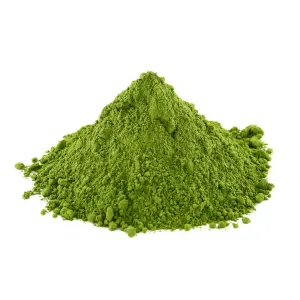These days, we see matcha tea everywhere. Read any menu board at any self-respecting coffee shop and you’ll see numerous options for matcha infusion into your favorite drink. Scan the ice cream aisle at the grocery and you’re bound to see at least a couple of matcha flavored treats. You can find matcha in a variety of high-end bottled iced teas at the local convenience store. Matcha has indeed made an incredible journey from China where it was first introduced in 2700 BC by emperor Shen Nong.
In 760 AD, Chinese scholar Lu Yu reported that Shen Nong was a dedicated researcher into the medical effectiveness of hundreds of types of roots, grasses and tree barks. According to Lu Yu, the emperor would test them all on himself, and if there were ill effects, he would clean the toxins from his body by eating tea leaves.

Eating tea leaves for medicinal purposes appears to be the original usage of the plant Camillia sinensis (the shrub from which all true tea comes), at its first introduction. By 220 AD people in Sichuan Province in western China were preserving their tea by compressing steamed leaves into hard bricks. They would then shave off bits to grind into a powder, which was then put into heated water and seasoned with ginger or onion for a medicinal drink.
By the Sui dynasty (581-618 AD) the practice of tea drinking was firmly established in the elite classes and among Buddhist monks, and began to filter down into the general population. By the 8th century tea shops were coming into play, and tea drinking became an essential part of life for everyone throughout Chinese urban environments.
When Japanese Buddhist monks were sent to China in the Heian period, they returned to Japan with tea. The first mention of tea drinking in Japan then appeared and by 814 AD, tea was being mentioned in poetry. Tea drinking in Japan remained an almost exclusively aristocratic ritual. It was only after Eisai, the founder of the Rinzai sect of Zen Buddhism, returned from China with a new way of drinking tea, that the practice fully took off. This new style was matcha, and was believed to enhance longevity.
Camillia sinensis is the plant from which all ‘true’ tea comes. It is how the leaves are harvested and handled afterwards that determines the type of tea that ends up in your cup. To make matcha, the plants are covered for up to three weeks prior to harvest. This shields the leaves from the sun, causing growth to slow down, and chlorophyll levels to rise. The finest tea buds are then hand-picked and laid out flat to dry. These leaves are then known as tencha, and their veins and stems are removed before being carefully stone ground into the fine bright green powder we know as matcha.
Because matcha tea is made from the entire tea leaf, it has been estimated that it may contain as much as 137 times the amount of certain catechins (plant compounds that act as antioxidants) than other types of green tea. https://www.ncbi.nlm.nih.gov/pubmed/14518774 . There have been 15 studies that found that drinking green tea is associated with decrease risk of liver disease. Other research showed that consuming 2 grams of green tea powder every day over a two month period helped improve cognitive abilities in elderly people. (https://www.ncbi.nlm.nih.gov/pubmed/25268837)
Test tube studies have shown that matcha is particularly high in epigallocatechin-3-gallate (EGCG). This is a catechin known to have powerful anti-cancer properties, and other in vitro studies have found that the EGCG in matcha was effective in killing off prostate cancer cells.
While it can be inspiring to witness the aesthetics of a Japanese tea ceremony, we don’t necessarily have to go to such lengths to enjoy the benefits of drinking matcha tea. It is easily found in the marketplace, and all you need to know is how to heat water! Just sift one or two teaspoons of powdered matcha into a cup, then pour about 2 ounces heated (not boiled!) water over it. Whisk it until it is completely blended and enjoy. From there, there’s no limit to how you might want to use matcha – try it in protein shakes, include it in pudding recipes, make your own matcha lattes!
More Information
Sources:
11 Surprising Matcha Tea Benefits
https://www.organicfacts.net/health-benefits/beverage/matcha-tea.html
The History of Matcha Tea
https://www.zenmatchatea.com/the-history-of-matcha-tea/
7 Evidence-Based Benefits of Matcha Tea
https://www.healthline.com/nutrition/7-benefits-of-matcha-tea#section6

